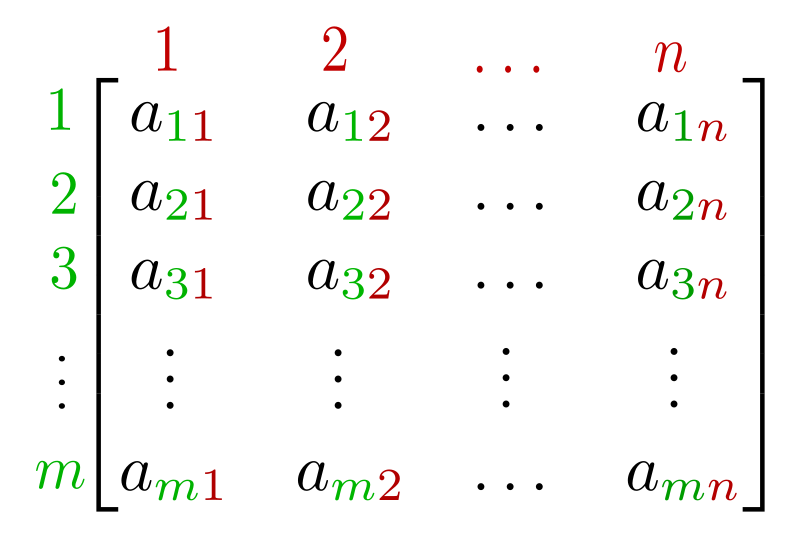Matrix Assignment¶
Matrices have many different uses and applications both in math and science. In fact, many of you will use matrices in physics in order to solve systems of equations.
In this assignment, you will write a class to find the inverse of a given matrix, if in fact the inverse exists. The inverse of a matrix is one such that when multiplied to the original matrix produces the identity matrix (a square matrix of all zeros except for ones along the diaganol). You can read about why the inverse is useful here .
There are various techniques for finding the inverse of a matrix. This assignment asks you to find it using elementary row operations . Each elementary row operation will be a method in your Matrix class, except for invert() which will call the other methods.
As with the Riemann Sums assignment, there is a Matrix JavaDoc to guide you. You will also create a MatrixApp class to test your Matrix and a MatrixTest test class with several test cases.
This assignment can seem very daunting at first. Before you decide what instructions you want to give your computer, you have to determine how you would manipulate a matrix first. So, we recommend that you start by trying to modify a few different matrices into the identity matrix by hand.
Note
Except for the methods that start with set__, none of the methods
should actually modify the original Matrix. Instead, they
return an entirely new Matrix. Make sure, when you are implementing
these methods, that you are not modifying the original Matrix, but
rather the Matrix that you will return.
It will be very important to identify your edge cases when you are testing. Again, much of the work of this project will be to refine your algorithm once you think you know what the basic logic should be. How will you handle non-square matrices? Uninvertible matrices?
Additionally, think about how you can tell your program is working correctly. It’s hard to look at an inversion of a matrix and tell if it’s correct, so try to use the properties of inverse matrices in order to make testing easier. Also remember that it is very hard to naturally come by a singular (i.e. uninvertable) matrix by chance, so you might want to intentionally create singular matrices.
Matrix Assignment¶
Remember to document as you go. Each method you write should have a documentation comment (ideally in the JavaDoc format) before it:
/**
* [DESCRIPTION OF WHAT THE METHOD DOES]
*
* @param left [DESCRIPTION OF THE 'left' PARAMETER]
* @param right [DESCRIPTION OF THE 'right' PARAMETER]
* @param subintervals [DESCRIPION OF THE 'subintervals' PARAMETER]
* @return [DESCRIPTION OF WHAT THE METHOD RETURNS]
*/
public double calculateDeltaX(double left, double right, int subintervals) {
// the actual method
}
Base Assignment¶
1. Matrix Class¶
Exercise
Summary: Create a Matrix object that performs common matrix operations.
In src folder, create a package namespace called
com.[yourname].matrix.In
matrixcreate a class calledMatrix.Add a
privateattribute calledmatrixthat is a two-dimensional array ofdoubles.Write the Matrix constructors according to the Matrix JavaDoc .
Implement the rest of the methods in the Matrix JavaDoc .
Optionally, create other helper methods to aid in inverting a matrix.
2. Test Classes¶
Exercise
Summary: Test the Matrix methods.
In the
testfolder, create a class calledMatrixTestand import all the necessary JUnit libraries.In the class, but outside of any methods, create a global Matrix variable of some size, e.g.
Matrix matrix = new Matrix(10, 10);Write several test methods to test every method in the
matrixobject. You can check the answers to an inverse matrix using a matrix inverse calculator.
When all of the tests pass you are done with this exercise.
3. MatrixApp¶
Extensions¶
After the base assignment is done, do more with your Matrix. You can use one of the ideas below or think of your own.
Extension Ideas
Another way to find the inverse of a matrix by using its determinant. Implement methods to find the determinant and use it to find the inverse.
Use your
Matrixclass to interpolate a polynomial given a set of points. Think about whether given n points what is the degree of the polynomial you will need to make.See if you can find a relationship between the derivative of an accumulation function (recall the Riemann sum assignment), and the accumulation function of the derivative of the function.
Use your
Matrixclass to balance a chemical equation. See this research paper on Balancing of Chemical Equations using Matrix Algebra.
You could also make a GUI. Even if you choose not to make a GUI, you should definitely have a way in which people can input their own polynomials through a command line interface.

